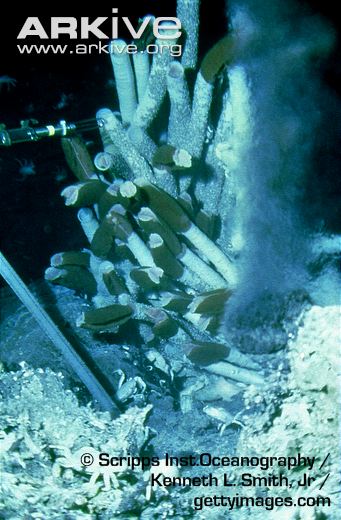Habitat and Geography
By: Roslyn Walhovd
Riftia pachyptila, or more commonly known as the giant tubeworm, inhabits one of the best examples of a harsh environment: hydrothermal vents miles beneath the ocean surface, also commonly referred to as “Black Smokers” due to their appearance. These vents can be found in various locations across the Pacific and seeps at continental margins(Cone, 1991). Because of the extremes of the habitat only a few types of unique organisms inhabit them including microorganisms, crabs, fishes, and our own Riftia pachyptila. Other types of fauna like the common red algae can not inhabit the same areas as Riftia pachyptila. They have to be able to withstand as much as 300 ATM elevated pressure (Black, et all 1997), complete lack of light, temperatures rapidly changing from 4°C to 350° C and chemical toxicity (Black, et. all 1997)(Cone, 1991).
 Hydrothermal vents are formed when seawater meets hot magma, this happens at
the divide of two tetonic plates, also know to be the site of crust
formation (Cone, 1991). This process heats the seawater up, dissolving large amounts of minerals. As the water
circulates it mixes with cool water forming mineral deposits and
vents. This forms a temperature and mineral gradient, which is
usable for chemoautotrophic organisms which can use these
dissolved chemicals to produce usable nutrients, much like other plants use
the sun. Chemoautotrophic organisms in a sense then is the key to life in
these harsh environments where other forms of usuable nutrients
are hard to come by (Cone, 1991)(Black, et. all 1997). These chemoautotrophic
organisms, bacteria, form symbiotic relationships with the
inhabitants of hydrothermal vents, much like we see in gut
bacteria of life above the surface. These chemoautotrophic
organisms live in the protection of the host and is
responsible for supplying the dissolved minerals form the
hydrogen sulfide rich environment (Feldback, 1981). The minerals are then
processed by the bacteria to provide enough food for itself and
its generous host.
Hydrothermal vents are formed when seawater meets hot magma, this happens at
the divide of two tetonic plates, also know to be the site of crust
formation (Cone, 1991). This process heats the seawater up, dissolving large amounts of minerals. As the water
circulates it mixes with cool water forming mineral deposits and
vents. This forms a temperature and mineral gradient, which is
usable for chemoautotrophic organisms which can use these
dissolved chemicals to produce usable nutrients, much like other plants use
the sun. Chemoautotrophic organisms in a sense then is the key to life in
these harsh environments where other forms of usuable nutrients
are hard to come by (Cone, 1991)(Black, et. all 1997). These chemoautotrophic
organisms, bacteria, form symbiotic relationships with the
inhabitants of hydrothermal vents, much like we see in gut
bacteria of life above the surface. These chemoautotrophic
organisms live in the protection of the host and is
responsible for supplying the dissolved minerals form the
hydrogen sulfide rich environment (Feldback, 1981). The minerals are then
processed by the bacteria to provide enough food for itself and
its generous host.
Another
obstacle of inhabiting these hydrothermal vents is the fact that
they are almost completely isolated from other marine
environments (MacDonald, et. all 1989). As you can image most marine life would perish
in such a difficult niche. These vents as we just learned are
not extremely common, they were only just discovered in 1977
(Cone, 1991)(Minic and Herve, 2004). Finding and colonizing new hydrothermal vent areas can
be very difficult. Riftia pachyptila has overcome this
difficulty somewhat in their type of reproduction. Female eggs
and male sperm are released into the environment and when
fertilized the larvae can life up to 40 days. This elongated
time period allows for Riftia pachyptila larvae to travel
distances of tens of hundreds kilometers to hopefully find and
cling to a new vent area (Feldbeck, 1981)(Black, et. all 1997). To this day Riftia pachyptila’s
life span is unknown. It is only noted that when the
hydrothermal vents cease, the days of this worm is numbered.
Dependent on the vent for the processes of life, the worms
shortly die out (Governar, et. all 2004).
Hydrothermal
vents are anything but easy to live in, it requires some extreme
specialization and even then this harsh environment is not a
cakewalk. Between huge amounts of pressure, dangerously high
temperature fluctuations, and extreme isolation, this place has
earned the right to the names “Black Smokers” and as Joseph Cone
said “Fire Under the Sea” (Feldbeck, 1981). Even our own amazing organism
Riftia pachyptila is at the will of these hydrothermal vents and
their processes.
For more information on organisms that live in light less habitates and their amazing specialization I would highly suggest reading about the bioluminescent astracod Photeros annecohenae. Several organisms that live with no light develop bioluminescense and it is a beautiful and intriguing adaptation.
Continue on to Form and Function